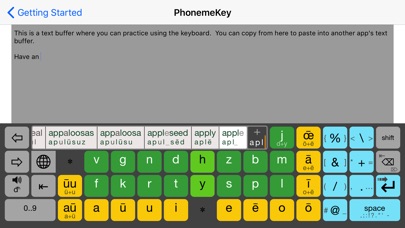
PhonemeKey app for iPhone and iPad
Developer: ROB ZUNDEL LLC
First release : 20 Dec 2017
App size: 43.55 Mb
Have you ever seen an 8 year old write? They spell “creatively” - just as the words sound. Their small motor skills are not well developed, so drawing letters is painful and exhausting. PhonemeKey solves all of these problems. It lets them enter sounds, not letters. It doesn’t challenge their motor skills. With every key pushed, the audio plays the sound for that symbol, to reinforce the relationship (which is most often the usual letter or similar to it).
There is just one sound per phoneme symbol. We have added a bar over the "long" vowels [āēīūō] to make them unique (just like most dictionary pronunciations use). We use a tick mark or a superscript (h or g) to make distinct, but still familiar, symbols for the digraphs (sh, ch, th, ng, etc.).
Most spelling trouble involves the vowels and the letters “h”, “y”, “w”, and “r”. Unless a word starts with one of these, you can just skip them. Words that start with the entered phonemes are displayed, ordered by typical use frequency, showing the correct spelling and the phonemes to pronounce each word. Tap one of the “guess” buttons to select that word (or punctuation to get the top guess). Most of the time, the word you want appears after entering only a few phonemes.
PhonemeKey is more efficient for adults, too! There are so many ways to write most sounds, even adults still make spelling mistakes. Besides spelling issues, why type all of those silent letters? And wouldn’t it be more convenient to be able to skip the vowels? As you become more advanced, you can slide between consonants (e.g., “br” or “nt”) to indicate they are to blend together without any vowels between, which improves the guess choices. You can even slide to several phonemes in a sequence (or to blank spots to indicate that some vowels might be there). When you are done sliding, the guesses update. If you are confident that you have enough letters that the first guess word will be the one you want, you can slide directly to a "space" key, and the first guess will automatically be chosen, ready for the next word.
The most common punctuation symbols are all available by sliding on the space bar. Others are available by tapping on a punctuation key (or by sliding off it in the direction of a secondary symbol). Spaces are automatically added after guess words you tap. Tap space again to insert a comma. Tap it again to change the comma to a period. Capitalization and spacing around punctuation is automatic.
You can slide up on a guess word to get derived words (e.g., plural or singular form, other verb forms, etc.). You can slide down on a guess to refine the guesses to words that start with the same phonemes (including the ones that you may have omitted). After selecting a word, the guess words change to words that are likely to follow the one just selected.
We have improved ease of access to numbers and other symbols, too. You can tap the "0..9" key to toggle between phonemes and numbers, but if you just need one or two, you can hold it with one finger, while you enter the needed symbols with another. The “alt” keys allow all of the numbers and symbols to be on one view (vs. having to toggle again to get symbols). You can slide between digits and symbols, too!
There are 5 different keyboard layouts and 8 color schemes to choose from. Each layout can be left- or right-handed. Some layouts use one or two "alt" keys (◰ or ◲), allowing up to three phonemes on a key. This reduces the size of the keyboard, making more room for your text. It can also reduce the total distance you have to slide.
You can toggle easily into direct text mode (for strange words not in our dictionary), and you can add your own words. Our dictionary comes with over 10,000 of the most commonly used words, including names, suffixes, and prefixes. You can make more by compounding words, prefixes, and suffixes. If you like it, consider using the in-app purchase to unlock additional words (~60,000).



